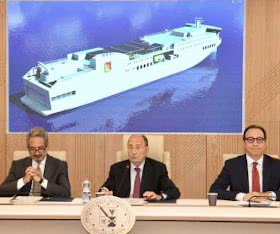
The President of the Sicilian Region, Renato Schifani, and
the Chief Executive Officer and General Manager of Fincantieri,
Pierroberto Folgiero, signed today in Palermo a contract for
the construction of a new ro-pax ferry for a basic amount
auction of almost 120 million euros. The ship, which will come
entirely built in the shipyard of Palermo, will be
owned by the regional authority and will carry out the
service connecting Sicily and the islands of Lampedusa and
Pantelleria.
The ferry, which will be delivered in 2026, will have
a length of about 140 meters and about 14,500 tons of tonnage
Gross. It can reach a maximum speed of 19 knots
and will have a capacity of 1,000 people and 200 cars.
The ship will be equipped with a dual fuel engine powered by
diesel and liquefied natural gas. It will also have a
photovoltaic system that, thanks to the accumulation of energy in a
battery unit, will guarantee the permanence in port with emissions
zero for about four hours.
 "Ours - underlined Schifani on the occasion of the
signature - is the first Region in Italy to field
funds that the Ministry of Transport has allocated to connections
by sea and is the first to be the total owner of
a ferry. We will improve quality and safety standards
of naval transport to Lampedusa and Pantelleria, with a ship
modern and that guarantees great attention also to respect
the environment'.
"Ours - underlined Schifani on the occasion of the
signature - is the first Region in Italy to field
funds that the Ministry of Transport has allocated to connections
by sea and is the first to be the total owner of
a ferry. We will improve quality and safety standards
of naval transport to Lampedusa and Pantelleria, with a ship
modern and that guarantees great attention also to respect
the environment'.
The Regional Councillor for Infrastructure and Mobility,
Alessandro Aricò, added that it is "a
extraordinary result: Sicily - he explained - is the
first Region in Italy to have commissioned a ship, financed
pursuant to Law 208/2015 establishing a finalized fund
direct purchase for the improvement of public transport. The
Region - specified Aricò - will have the possibility,
As foreseen by the announcement, to exercise the option for the
construction of a second vessel'.
"The award of this order - he commented
Folgiero - represents an important test for Fincantieri. In a
industrial sector that over time has moved to
Asian shipyards, we have the opportunity to bring back
Italy the production of ferries, rehabilitate our skills
historical in the industry and demonstrate the ability to be
competitive while ensuring the highest standards
productive, with benefits in terms of uptime and
sustainability that will reach the end user. Point
The strength of our project are, once again, the technologies
for the reduction of environmental impact, which intercept the
needs of the energy transition, designed to outline the
the maritime transport sector of tomorrow'.